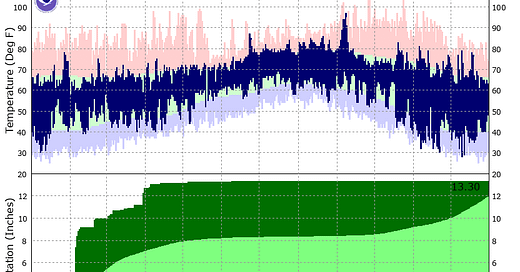In honor of the flu that is currently taking its sweet time to leave my body this week, let’s talk about some disgusting water down here in Southern California.
Southern California's coastline offers year-round waves and year-round water quality challenges, especially after rain. While waiting 72 hours post-rainfall before surfing might sound excessive to visitors, San Diego's geography and urban development create conditions that make this precaution particularly important.
San Diego County's long dry spells set the stage for concentrated contamination. In 2024, the coastal region saw roughly one inch of rainfall between April and January - nearly 10 months where pollutants accumulated across the landscape. Urban runoff carries a toxic blend: pesticides and fertilizers from agricultural areas, oil and rubber particles from roads, industrial waste, untreated sewage, and a Smithsonian-caliber collection of fecal matter from local wildlife. When rain finally arrives, these materials wash into the ocean in concentrated pulses.

The Tijuana River adds another layer of complexity to our local water quality. As Mexico's second-largest city expands, its aging infrastructure struggles to process sewage during rain events. Untreated waste flows northward, creating a pollution plume that can extend surprisingly far along the coast, as demonstrated by recent nearshore current studies that I will write about in detail in the future.
The ocean's ability to dilute these pollutants depends on what oceanographers call residence time - how long a packet of water remains in a particular location. This varies based on ocean currents, wave conditions, and coastal topography. Mission Bay, for instance, collects runoff from surrounding areas before releasing it near Dog Beach. The bay's shape and location mean pollutants can linger rather than quickly dispersing offshore.
San Diego's military presence also influences water quality. The extensive Naval fleet uses antifouling paint designed to prevent marine growth on ship hulls, adding another source of contamination to our urban watershed. This stuff is designed to kill living organisms. Combined with downtown's proximity to the bay, other heavy-metal sources, and the county's extensive road network, these factors create a perfect storm of pollution potential during rainfall.
Getting sick from contaminated ocean water isn't just about an upset stomach - though that's definitely part of it. The contaminants in post-rain runoff can cause a range of infections, from ear and eye irritation to more serious gastrointestinal and respiratory illnesses. Bacteria like E. coli and enterococci thrive in these conditions, while viruses including hepatitis and norovirus can survive in seawater for days. The risk isn't just from swallowing water - these pathogens can enter through your ears, nose, eyes, or even small cuts. During major rain events, bacterial counts near river mouths can spike to hundreds or even thousands of times above federal health standards.
The 72-hour waiting period doesn't guarantee all pollutants have cleared, but rather indicates when contamination levels typically approach baseline conditions. These baseline conditions vary significantly by location - some breaks maintain decent water quality outside of rain events, while others near river mouths or storm drains face persistent challenges. Not to mention the influence from the DDT and nuclear and industrial waste dump sites offshore of LA.
If you're determined to surf right after rain, avoid river mouths, storm drains, and bay outflows, where pollutant concentrations are highest. But the smartest choice is waiting those three days - your immune system does not like drinking sewage.
Further Reading:




I spent years ignoring that kind of advice and never had a serious issue. This was on the northern beaches of Sydney, before the deepwater outfalls, primary treated sewage was discharged at the base of a cliff we could see from our usual spots. Then there were the local lagoons which collected stormwater and run off and dischsrged it all at once when the water level rose higher than rhe sand blocking it. One bloke I knew died from an infection he picked up in an open would and left untreated until it was too late. So if you are going to do it....be careful and treat symptoms promptly.